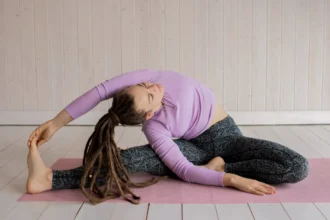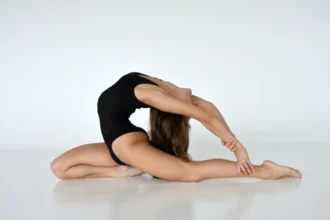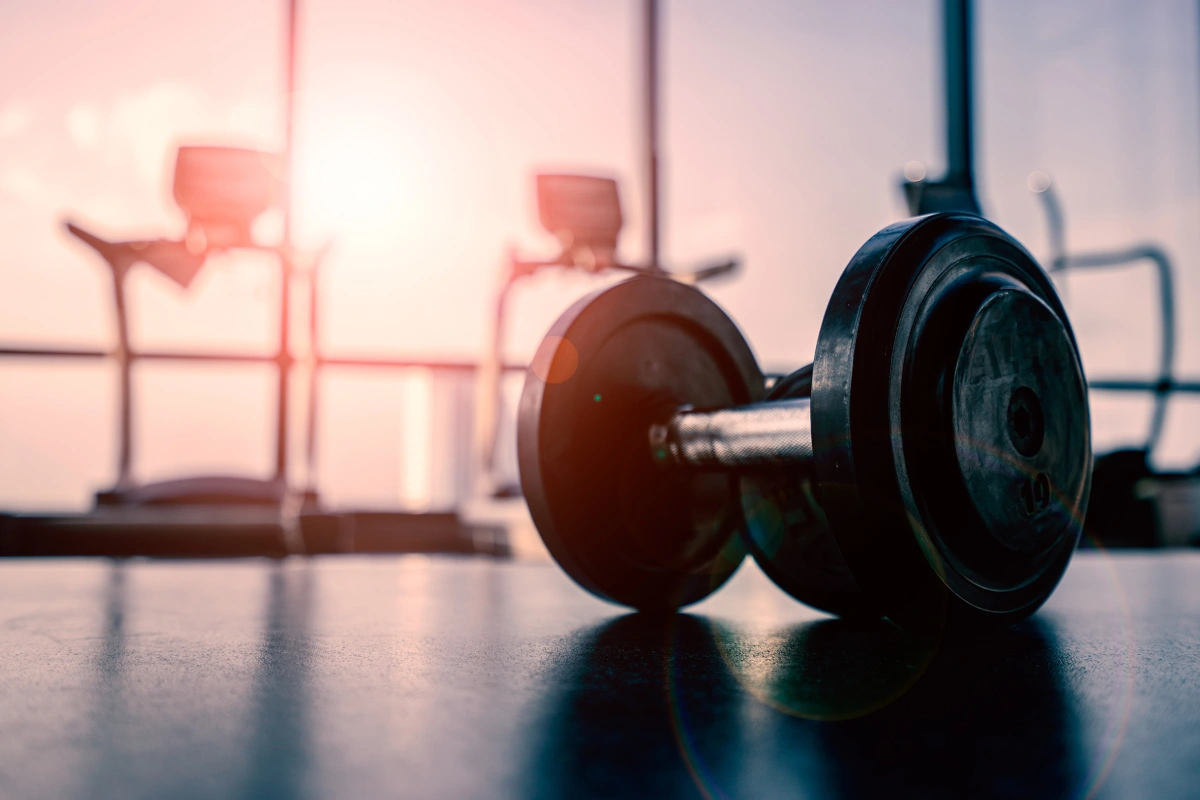If you’ve ever wondered whether gymnasts use weights in their training, the answer is yes! However, gymnasts don’t use weights in the same way as bodybuilders or weightlifters. Their focus is on developing relative strength—strength that allows them to perform gymnastic skills with precision and control.
While bodyweight exercises are their primary training method, dumbbell exercises play an important supplementary role in strengthening specific muscles for optimal performance. By incorporating weights, gymnasts can:
- Reduce the risk of injury through controlled, progressive overload.
- Prepare their muscles for demanding skills.
- Strengthen targeted areas.
In this article, we’ll explore the top dumbbell exercises that gymnasts use to enhance their strength and improve their skills.
Front Raises
Front raises are pivotal in building straight arm strength, which is a cornerstone of many gymnastics skills. Gymnasts use this exercise to target the deltoids, trapezius, and upper body muscles that are crucial for movements like the planche, handstand to planche, and planche presses.
The focus on straight arm positioning makes this exercise unique, as it helps gymnasts avoid any form breakdown during complex skills.
How to Perform It:
- Stand tall with a slight posterior pelvic tilt (engaging your glutes) and your core fully braced.
- Hold a dumbbell (or weight plate) in each hand with your arms extended straight in front of you. Your wrists should be slightly rotated outward (as if you’re holding a tray).
- With locked elbows, raise your arms forward until they reach ear level, aiming to get your arms nearly vertical.
- At the top of the movement, elevate your shoulders, keeping your arms straight throughout.
- Slowly lower the weights back to the starting position, ensuring your arms don’t bend.
Progression:
Start with lighter weights (5–10 pounds) and perform high-rep sets (around 12–15 reps). As you become more comfortable, increase the weight and gradually reduce the number of reps to about 6–8 per set. The goal is to challenge the shoulders while maintaining form.
Planche Press
The planche press is a key movement that directly targets the shoulder, chest, and core muscles used in both the planche and Maltese positions. This exercise mimics the same straight-arm engagement required for these advanced gymnastics skills, which makes it an effective strengthening tool.
How to Perform It:
- Lie on your back with your knees bent or in a hollow-body position, which engages your core.
- Hold dumbbells with your palms facing forward, extending your arms straight above your chest.
- Raise the dumbbells directly upward, keeping your arms straight as you press them to about a 45-degree angle from the floor.
- You can also perform this exercise on an elevated surface (like a bench), which allows for greater range of motion, or you can focus on performing negative reps (slowly lowering the weights).
- At the top of the movement, pause briefly before returning the dumbbells to the starting position.
Progression:
Begin with light weights (5–10 pounds) and perform sets of 12–15 reps. For added difficulty, you can increase the weight and perform lower-rep sets (6–8) as you build strength.
Victorian Lift
The Victorian lift targets the rear deltoids, triceps, and upper back, all of which are essential for gymnasts working on Victorian, iron cross, and other high-level ring skills. This exercise is an antagonist movement to those requiring shoulder flexion, allowing for balanced shoulder strength development.
How to Perform It:
- Set up by lying face down on a bench or other elevated surface. Your body should remain aligned and tight, with your core engaged throughout.
- Hold a dumbbell in each hand with your elbows locked and close to your body.
- With your chest supported by the bench, raise your arms out to the sides (laterally), keeping your elbows straight.
- To increase intensity, you can slightly extend your arms behind your body, focusing on engaging the rear deltoids and triceps.
- Slowly lower the weights back to the starting position, maintaining control of the movement.
Progression:
As with other exercises, start with light weights (5–10 pounds) and higher reps (12–15). Over time, increase the weight and lower the reps to challenge your strength. Gymnasts typically progress up to 25–35 pounds as their shoulders become stronger.
Maltese Circles
Maltese circles are an advanced variation of the planche press that specifically targets the shoulders, chest, and core while also engaging the back.
The movement mimics the circular arm motion seen in advanced gymnastic skills like the iron cross and swing to planche on the rings. This exercise helps gymnasts build the shoulder and core stability necessary for these powerful skills.
How to Perform It:
- Begin by lying on your back, holding a dumbbell in each hand.
- Extend your arms straight above your chest, with your palms facing each other.
- Slowly raise your arms in a circular motion—beginning from a straight-out position, then up toward your head, and back around to the starting point.
- Focus on keeping your core engaged and stabilizing your lower back as you perform the circles. The slower and more controlled the motion, the better.
- As your arms circle, try to keep your arms straight without letting your elbows bend.
Progression:
Start with light weights (5–10 pounds) and perform high-rep sets (12–15 reps). As you gain control, increase the weight slightly and adjust the reps to 6–8 per set for a more intense challenge.s.
Inverted Press
The inverted press is a key exercise for gymnasts training for the inverted cross on the rings, as well as skills like the Japanese handstand or ring giants. This movement strengthens the shoulders, upper back, chest, and arms, making it crucial for maintaining control in these complex movements.
How to Perform It:
- Stand in a stable position, either with your feet in a straddle or closed stance.
- Hold a dumbbell in each hand, palms facing forward, at shoulder height.
- Press the dumbbells straight up, locking your elbows as you push the weights overhead.
- Slowly lower the dumbbells to shoulder height, maintaining control of the movement and avoiding any arching in your lower back.
- Perform the movement slowly to engage the shoulders, focusing on a full range of motion.
Progression:
Start with light dumbbells (5–10 pounds) and focus on higher reps (12–15). Gradually increase the weight and lower the reps to 6–8 as your strength develops. Gymnasts often use a max of 20–25-pound dumbbells as they build their strength.nd focus on higher reps (12–15), gradually increasing weight as you get stronger.
Shoulder Press
The shoulder press is crucial for gymnasts, particularly for movements like the handstand push-up and press to handstand. This exercise targets the front deltoids and shoulders, both of which are essential for stabilizing the upper body in inverted positions.
It’s an open kinetic chain movement, meaning it engages the muscles differently than the closed kinetic chain movement of a handstand push-up.
How to Perform It:
- Stand with your feet shoulder-width apart, maintaining a posterior pelvic tilt (tightening your glutes and engaging your core).
- Hold a dumbbell in each hand at shoulder height, with your palms facing forward and elbows slightly bent.
- Press the dumbbells upward, locking your elbows at the top of the movement.
- Lower the dumbbells slowly to shoulder height, ensuring that your back remains neutral and there is no arching.
- Keep your core and glutes engaged throughout the movement.
Progression:
Begin with lighter weights (5–10 pounds) and focus on higher reps (12–15). Once your shoulders adapt, increase the weight slightly and lower the reps to 6–8. This exercise helps gymnasts maintain strength after performing more complex handstand push-ups and other overhead movements.
Conclusion: Dumbbells as a Supplement to Gymnastics Training
In gymnastics, strength training is all about specificity. While gymnasts rely primarily on bodyweight movements, dumbbell exercises play a crucial role in developing the strength needed for complex routines.
The six dumbbell exercises—front raises, planche presses, Victorian lifts, Maltese circles, inverted presses, and shoulder presses—are essential for building the strength and stability required for successful gymnastics performance. Incorporating these exercises into a training routine can make a significant difference in improving overall gymnastic performance.





